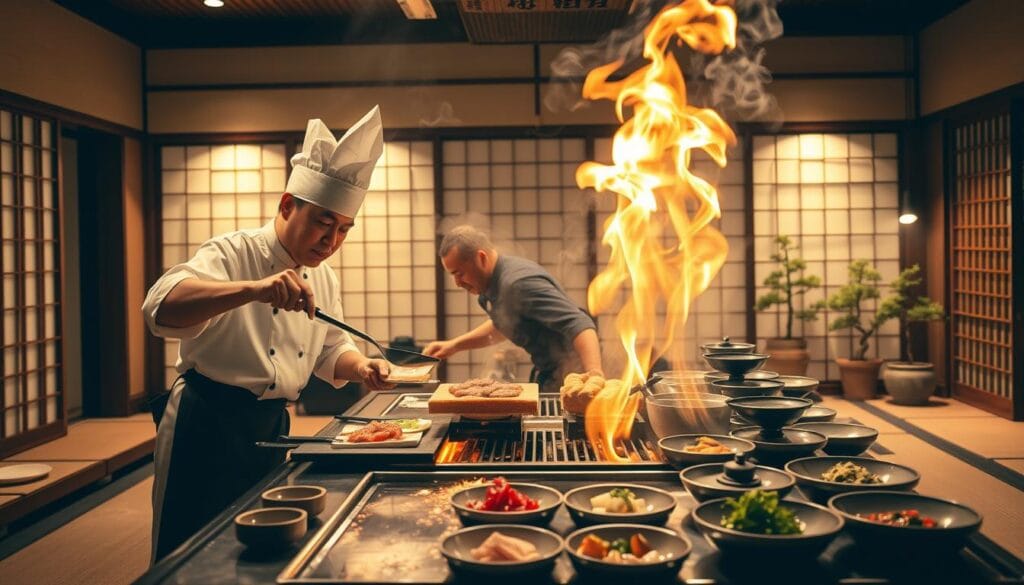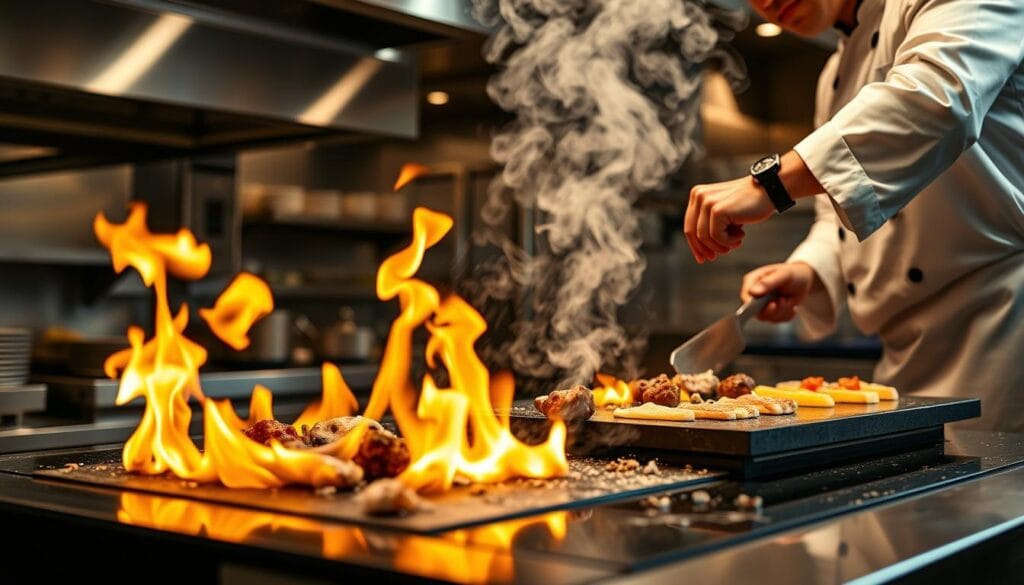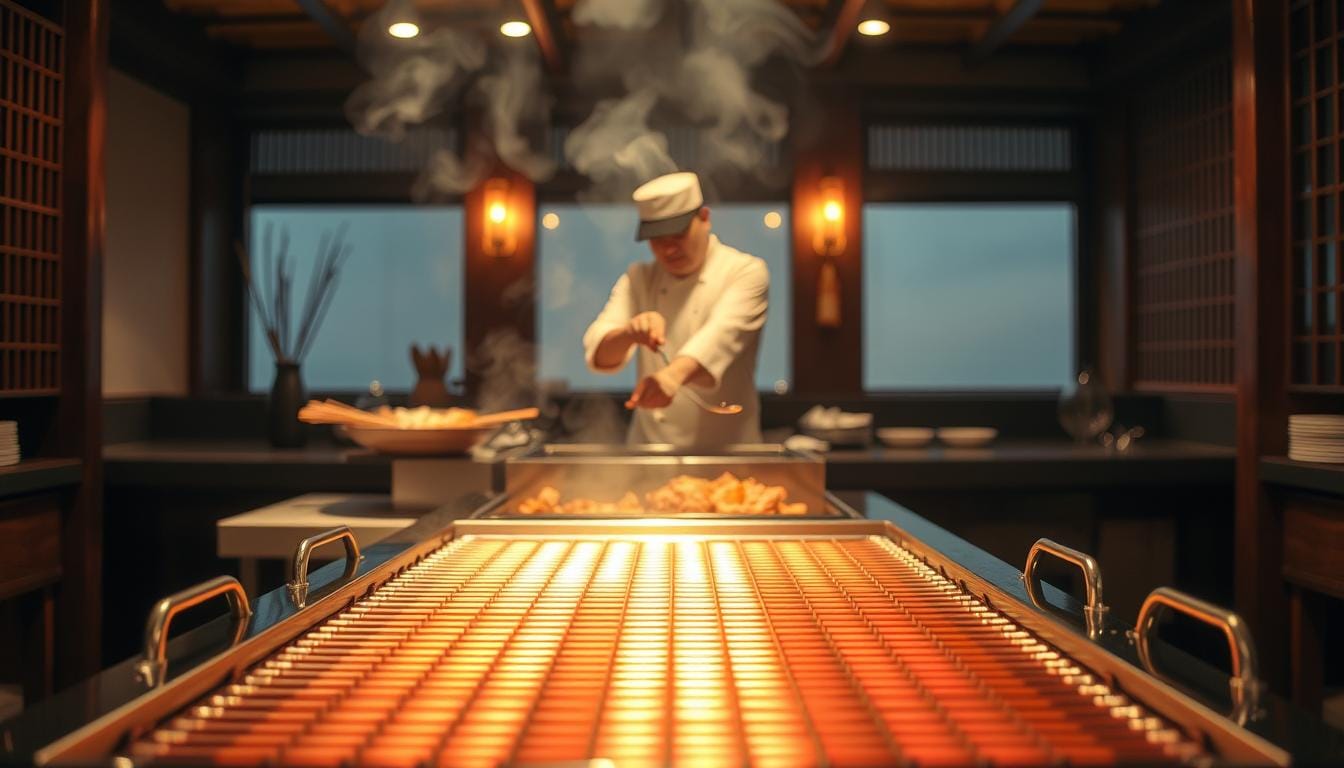How to Make an Easy Hibachi Recipe at Home
Table of Contents
Hibachi cooking is loved by many for its sizzling sounds, dramatic flames, and amazing flavors. Growing up, I loved watching chefs turn simple ingredients into magic at restaurants.
Bringing that magic to your kitchen might seem hard, but it’s easier than you think. With a few techniques and basic tools, you can make hibachi dishes at home without spending a lot.
This guide will teach you all about making a perfect hibachi recipe. You’ll learn how to pick the right ingredients and master cooking techniques. Soon, you’ll be making meals that will wow your family and friends.
Whether you’re new to cooking or have been doing it for years, this guide will make your kitchen a fun place. You’ll learn the art of Japanese cooking that’s both easy and tasty.
Understanding the Art of Hibachi-Style Cooking
Hibachi cooking is a unique way to make meals. It comes from Japan and is loved for its interactive and tasty approach. It turns cooking into a fun show.
The magic of hibachi cooking is in its special method. It uses high heat to lock in flavors. This makes meals taste amazing and look great while being made.
What Makes Hibachi Cooking Special
Blackstone hibachi cooking is special for many reasons:
- High-heat cooking that quickly sears ingredients
- Interactive cooking style that entertains diners
- Emphasis on fresh ingredients and precise techniques
- Combines cooking and performance art
Traditional vs. Modern Hibachi Methods
Old hibachi used open charcoal grills. Now, modern methods use Blackstone griddles. This makes it easier for home cooks to try hibachi.
Essential Equipment for Home Hibachi
To cook hibachi at home, you need some important tools:
- Flat-top griddle (Blackstone hibachi works great)
- High-heat resistant cooking utensils
- Sharp chef’s knife
- Cooking oils with high smoke points
Whether you’re a pro chef or just starting, hibachi cooking is exciting. It brings new flavors and fun to your kitchen.
Essential Ingredients for the Perfect Hibachi Recipe
To make a great hibachi beef dish, start with the right ingredients. Begin by learning about the key parts that make hibachi cooking unique.
Proteins are the main part of any hibachi meal. For hibachi beef, pick top-quality cuts like ribeye or sirloin. These cuts are tender and full of flavor, perfect for hibachi cooking.
- Prime beef cuts (ribeye, sirloin)
- Chicken breasts
- Fresh shrimp
- Seasonal vegetables
Vegetables are also important in your hibachi beef recipe. Choose fresh, crisp veggies that can handle high heat. Zucchini, onions, mushrooms, and bell peppers add color and nutrition to your dish.
Seasoning makes your hibachi beef truly special. Key seasonings include:
- Soy sauce
- Fresh garlic
- Ginger
- Sesame oil
Success in hibachi cooking depends on using the best ingredients. Choose fresh, high-quality proteins and veggies for a meal that’s as good as a restaurant’s.
Preparing Your Hibachi Workspace and Tools
Starting a hibachi recipe needs a well-organized kitchen. Your workspace is key for authentic hibachi cooking at home. With the right setup, your kitchen becomes a lively place, just like a traditional hibachi grill.
- Clear a spacious countertop area for ingredient preparation
- Gather all necessary cooking tools in advance
- Ensure proper ventilation near your cooking station
- Keep a fire extinguisher nearby as a safety precaution
Setting Up Your Cooking Station
Your hibachi recipe needs a well-organized cooking area. Choose a large, flat griddle or flat-top surface that can handle high temperatures. Cast iron or heavy-duty steel surfaces are best for authentic hibachi cooking.
| Essential Hibachi Tools | Purpose |
|---|---|
| Flat griddle | Primary cooking surface |
| Cooking spatulas | Flipping and moving ingredients |
| High-heat resistant gloves | Safety protection |
| Oil dispenser | Controlled ingredient distribution |
Temperature Control Tips
Mastering temperature is key for a great hibachi recipe. Use a reliable cooking thermometer to check heat levels. Aim for high heat between 400-450°F for that perfect sear and flavor.
Safety Measures to Consider
Safety is always first when making a hibachi recipe. Keep flammable items away from the cooking area, wear protective clothing, and never leave your cooking station unattended. Practice proper heat management and have all ingredients prepped before starting to cook.
Mastering Hibachi Fried Rice Techniques
Making perfect hibachi fried rice needs skill and focus. Start by picking the right rice and preparing it right. For real hibachi fried rice, use day-old rice that’s cooled and separated. This stops it from clumping when you cook it.
The secret to great fried rice hibachi style is cooking at high heat and using the right technique. Here are the key steps:
- Use cold, day-old rice for the best texture
- Get your ingredients ready before heating the pan
- Cook eggs separately for a clean taste
- Keep the heat high while cooking
Your hibachi fried rice technique should aim for quick, even cooking. Scramble eggs first and set them aside. Stir-fry veggies quickly to keep them crisp. When adding rice, spread it out and let it get a bit crispy without burning.
Seasoning is key in authentic hibachi fried rice. Soy sauce, butter, and a bit of sesame oil can make your dish top-notch. But remember, less is more. You want to boost the rice’s flavor, not hide it.
“Perfect hibachi fried rice is about balance, heat, and technique.” – Professional Hibachi Chef
Getting better at hibachi fried rice takes practice. Don’t worry if your first tries aren’t perfect. With each attempt, you’ll get better at controlling the heat and timing your ingredients.
Creating the Perfect Hibachi Protein Marinades
Marinating is key to making hibachi dishes stand out. The right marinade can turn simple proteins into amazing hibachi dishes. Learning how to marinate unlocks deep, complex flavors that make hibachi cooking unique.
The secret to a great marinade is finding the right balance of flavors. It’s about knowing how different ingredients work together with your proteins. Marinades mix several key parts to boost taste and texture.
Classic Marinade Components
- Soy sauce for umami depth
- Sesame oil for richness
- Fresh garlic for pungency
- Grated ginger for warmth
- Optional sweeteners like honey or mirin
Hibachi Beef Marinade Secrets
For hibachi beef, the marinade must tenderize and enhance the meat’s natural taste. A top hibachi beef marinade includes:
- Soy sauce as the base
- Worcestershire sauce for complexity
- Minced garlic and ginger
- A touch of brown sugar for caramelization
Marinating Tips for Best Results
Marinating times depend on the protein. Hibachi beef does well with 2-4 hours, while chicken needs 30 minutes to 2 hours. Always marinate in the fridge and use a non-reactive container to avoid metallic tastes.
Pro tip: Never reuse marinade that has been in contact with raw meat. Always prepare a fresh batch for basting or as a sauce.
Step-by-Step Hibachi Recipe for Beginners
Making a hibachi recipe at home might seem hard, but it’s doable. This guide will help you make a delicious hibachi meal. It’s as good as what you’d find in a restaurant.

Start by picking the best ingredients. Good preparation and knowing how to cook are key. You’ll need:
- Fresh protein (chicken, beef, or shrimp)
- Mixed vegetables
- Soy sauce
- Cooking oil
- Salt and pepper
First, marinate your protein for extra flavor. Pro tip: Marinate chicken or beef for at least 30 minutes before cooking. Cut your protein and veggies into the same size pieces for even cooking.
“The secret to great hibachi is high heat and quick cooking” – Professional Hibachi Chef
To cook your hibachi, use a flat surface like a griddle or big skillet. Heat it up high and start with your protein. Cook each side until it’s golden, then set it aside. Then, stir-fry your veggies with some soy sauce.
- Preheat cooking surface
- Cook protein until golden
- Sauté vegetables
- Combine ingredients
- Serve hot
Your homemade hibachi recipe is now ready to wow your family and friends. It’s full of restaurant-style flavors and techniques.
Signature Hibachi Sauces and Condiments
Sauces are key to any great hibachi recipe. They make simple meals into unforgettable dishes. Whether cooking at home or trying to match restaurant flavors, learning these sauces is essential.
The right sauce can make a simple dish special. Hibachi chefs see these condiments as more than just sides. They’re a big part of the dish’s flavor.
Classic Yum Yum Sauce Recipe
Yum Yum sauce is the star of hibachi condiments. It’s creamy, tangy, and adds a unique taste to any dish.
- Ingredients:
- 1 cup mayonnaise
- 2 tablespoons tomato paste
- 1 teaspoon garlic powder
- 1 teaspoon paprika
- Dash of cayenne pepper
- Preparation steps:
- Whisk all ingredients together
- Refrigerate for at least 1 hour
- Stir before serving
Ginger Sauce Preparation
A zesty ginger sauce brightens any hibachi dish. It’s great with grilled meats and veggies.
- Key ingredients:
- Fresh ginger root
- Soy sauce
- Rice vinegar
- Sesame oil
Mustard Sauce Variations
Mustard sauce adds a spicy touch to hibachi. You can make it as hot or mild as you like.
“The perfect sauce can transform a good hibachi recipe into an unforgettable meal!” – Professional Chef
Pro tip: Keep these homemade sauces in airtight containers in the fridge. They stay fresh for 5-7 days. This lets you make them ahead of time and enjoy top-notch hibachi at home.
Vegetable Preparation and Cooking Methods
Learning how to prepare vegetables is key for a great hibachi recipe. The right methods can turn simple ingredients into a dish that’s both tasty and impressive.
Choose fresh, crisp vegetables for your hibachi recipe. They should be able to handle high heat. Some top picks include:
- Zucchini
- Yellow onions
- Button mushrooms
- Colorful bell peppers
- Carrots
It’s important to cut vegetables evenly for even cooking. Cut them into pieces that are about 1/2 to 3/4 inch thick. This helps them cook well and keeps their texture and flavor.
Here are some tips for preparing perfect hibachi vegetables:
- Wash vegetables well
- Pat them dry with a clean towel
- Use sharp knives for clean cuts
- Let vegetables sit at room temperature before cooking
Cooking techniques are vital for your hibachi recipe. Use high heat and quick movements to get that seared outside and tender inside. A flat griddle or cast-iron skillet is best for authentic hibachi-style vegetables.
The secret to great hibachi vegetables is speed and high temperature!
Seasoning is also important for your vegetables. A light butter brush, some salt, and garlic powder can make them stand out in your hibachi recipe.
Tips for Achieving Restaurant-Quality Results
To make your home cooking as good as a restaurant, you need to learn a few key skills. Professional chefs know that it’s not just about what you use. It’s about how you use it, with skill, precision, and how you present it.

To get better at blackstone hibachi, focus on three main areas. These areas help you go from being a beginner to a pro like a restaurant chef:
Mastering Temperature Control
Temperature is key to great hibachi cooking. Your griddle needs to stay hot to get those crispy edges and seared proteins just right.
- Preheat your blackstone hibachi griddle for at least 10 minutes
- Use infrared thermometers for precise surface temperature tracking
- Maintain cooking zones between 400-450 degrees Fahrenheit
Perfecting Timing and Coordination
Good hibachi cooking needs you to be precise and quick. You have to manage many ingredients at once.
- Prep all ingredients before starting cooking
- Cook proteins first, then vegetables
- Use separate griddle sections for different ingredients
Professional Presentation Techniques
How your dish looks is just as important as how it tastes. Make your hibachi look like it came from a restaurant by paying attention to how you plate it and the cooking show you put on.
| Technique | Impact |
|---|---|
| Stacking Ingredients | Creates height and visual interest |
| Sauce Drizzling | Adds professional finishing touch |
| Garnish Placement | Enhances overall dish presentation |
“Great cooking is about passion, technique, and transforming simple ingredients into extraordinary experiences.” – Professional Chef
With practice and focus on these tips, you can make blackstone hibachi meals that are as good as those in restaurants, right in your own kitchen.
Common Mistakes to Avoid When Making Hibachi
Mastering a hibachi recipe takes practice. Even experienced cooks can make mistakes. Knowing these errors can help you make a better hibachi meal.
- Rice Preparation Mistakes: Freshly cooked rice can be mushy. Use day-old rice that’s been chilled. This keeps the grains separate and crisp.
- Protein Cooking Errors: Overcooking proteins is a big mistake. Chicken, beef, and seafood need quick cooking at high heat to stay tender and flavorful.
- Heat Management Challenges: Wrong cooking temperature can spoil your dish. Low heat steams, while high heat burns too fast.
Seasoning is key in hibachi cooking. Many chefs add too little or too much salt and soy sauce. Start with small amounts and taste as you go. You can always add more, but can’t take it away.
Your cooking surface is very important. A crowded pan prevents searing and leads to steaming. Cook in batches to ensure each ingredient browns well.
Pro tip: Invest in a large, flat cooking surface like a griddle or cast-iron skillet to replicate authentic hibachi cooking techniques.
Avoiding these mistakes will help you make great hibachi recipes at home.
Meal Planning and Prep Tips for Hibachi Dinners
Planning your hibachi fried rice dinner can make cooking easier and more fun. It’s all about efficient meal prep to get that restaurant taste at home.
First, learn about mise en place. It means getting all your ingredients ready before you start cooking. This is super important for hibachi fried rice and other dishes.
- Chop vegetables in advance
- Marinate proteins the night before
- Cook rice ahead of time
- Measure out sauces and seasonings
Good meal planning can really improve your hibachi cooking. Here are some tips to help you prep faster:
| Preparation Step | Time Saved | Difficulty Level |
|---|---|---|
| Pre-cutting vegetables | 15-20 minutes | Easy |
| Marinating proteins | 30 minutes | Medium |
| Preparing hibachi fried rice base | 25 minutes | Easy |
Think about what everyone likes to eat and how many people you’re serving. Flexibility is key. Use ingredients that can be changed up to fit different tastes and diets.
Save time on busy nights by cooking rice in bulk, measuring spices ahead, and keeping your kitchen tidy. These tips will help you make tasty hibachi fried rice without stress.
Conclusion
Creating a hibachi recipe at home is more than cooking—it’s an art. It brings excitement to your kitchen. Now, you can make meals that are as good as those in professional restaurants.
Improving your hibachi recipe skills takes practice and trying new things. Start with basic steps like controlling cooking temperatures and making marinades. Each time you cook, you’ll get better and find new ways to improve your cooking.
Hibachi cooking is about making memories with family and friends. Invite them to help you cook and share your skills. Your home can become a place where everyone can enjoy making delicious meals together.
Keep learning and exploring hibachi recipes. Don’t be afraid to change recipes and try new things. With hard work and passion, you’ll soon make hibachi meals that will wow everyone at your table.
FAQ
What equipment do I need to make hibachi at home?
Is hibachi cooking difficult for beginners?
What are the best proteins for hibachi recipes?
How important is the rice in a hibachi recipe?
Can I make hibachi recipes for dietary restrictions?
What sauces are typically used in hibachi cooking?
How do I achieve the signature hibachi cooking style at home?
What vegetables work best in hibachi recipes?
How long should I marinate hibachi proteins?
Can I prepare hibachi ingredients in advance?
Did You Try Our Recipe?
There are no reviews yet. Be the first one to write one.

